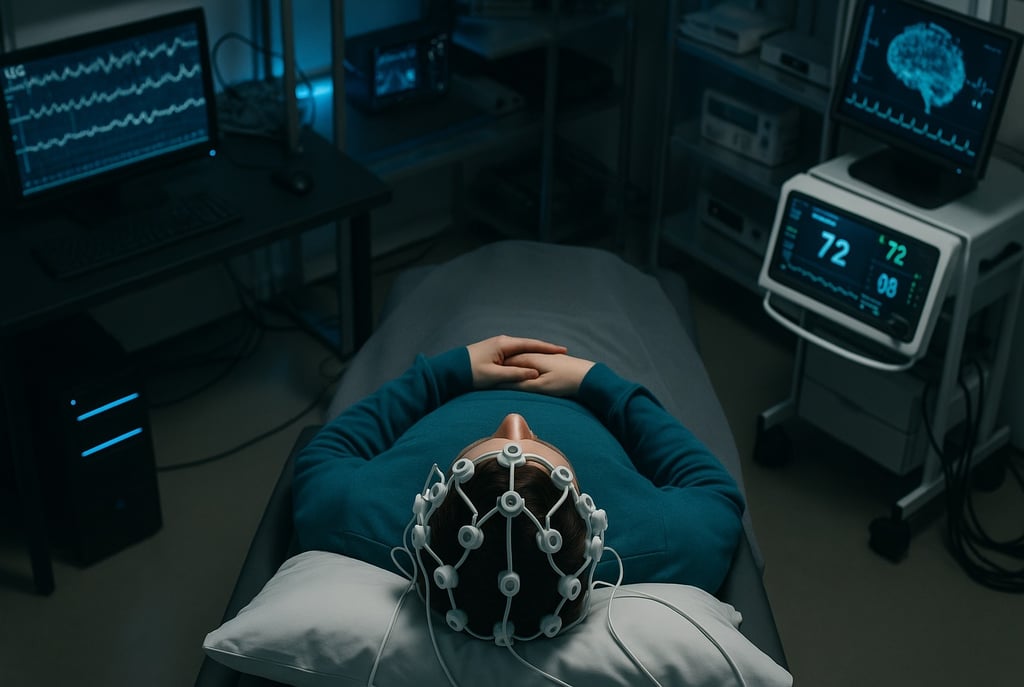They’ve Finally Found a Way to Hack You in Your Sleep
A Silicon Valley startup claims to have transmitted a word between two dreamers using lucid-state tech. What begins as science could become the world’s first dream network where even your subconscious is online.
FUTURE AND TECH
10/26/20253 min read


A Silicon Valley startup has just claimed something that sounds equal parts Inception and patent-law fever dream: two people reportedly communicated while asleep.
The company, called REMspace, says it achieved “dream-to-dream” contact, one person sent a single word during a lucid dream, and another received it eight minutes later while also asleep. The message was relayed through a server, not some telepathic ether, but that’s almost irrelevant. The line has been crossed. Someone just plugged the subconscious into the network.
For decades, researchers have known that lucid dreamers can communicate with the waking world. They can answer maths questions, signal through eye movements, even perform tasks on request. But what REMspace claims is different, it isn’t dialogue between a dreamer and a scientist, it’s dreamer to dreamer. Two minds, asleep, reaching across the darkness with a single piece of data.
The company calls the system Remmyo, a “dream language” made of symbols participants train themselves to associate with words. The detection tech uses sensors to pick up tiny muscle twitches around the face and throat, subvocal micro-movements that happen when you think a word but don’t say it. These signals were digitised, run through a server, and played to the second dreamer through faint tones. One person whispered into the void, the other heard it later.
So no, this isn’t mind-to-mind telepathy. It’s a prototype for the internet of dreams, where thoughts, signals, and data pass between sleeping minds with machine assistance.
It’s small. It’s clumsy. And it changes everything.
Right now, the message was just a single word, relayed with latency measured in minutes. But so was the first email. At first it was pointless. Then it restructured civilisation. Every major network starts as a trivial message between two endpoints.
As non-invasive brain-computer interfaces improve, like BrainNet and the semantic-decoding frameworks in Neuro2Semantic, this will scale. You’ll hear the phrase “DreamNet” one day, and it won’t be science fiction.
Imagine it: sleep as a social platform. A place where you can meet others in shared lucid spaces, collaborate, replay memories, or confront fears in a safe sandbox. Psychologists will call it therapy. Corporations will call it productivity. Marketers will call it immersive engagement. The rest of us will just call it normal, until the morning you wake up and realise your dreams are no longer yours.
The commercial push is already obvious. REMspace also sells AI-powered sleep masks that promise “lucid control training.” They’re turning the unconscious into a subscription service. We’ve already given up our clicks, voices, faces, and location data while awake. Now the only state left unmonetised is the one where we can’t click “Decline.”
If neural data can be harvested mid-dream, the mind becomes the product even while unconscious. Companies already use biometric analytics to measure engagement, imagine that extended to emotional reactions during dreams. As VeraSafe warned, mental-privacy law is years behind. There’s no GDPR for your REM cycle, no consent form for subconscious manipulation. The first dream networks will almost certainly be rolled out under the same cheerful pretext every surveillance technology begins with, it’s for your well-being.
The neuroethicists are already panicking. The idea that someone could inject information into your mind while you’re asleep, when your defences are lowest, is the ultimate invasion of privacy. A targeted advert here. A “therapeutic nudge” there. The potential for subtle behavioural influence is limitless, and entirely deniable. If it happens in your dream, who do you even blame?
But let’s be honest, you’d probably still try it.
If you could design your dreams, pick the setting, the faces, the ending, would you hand that power to a machine? Would you let it record what you see, what you feel, what you fear, and feed it back to you the next night? Most people would. We already surrender control of our digital selves in exchange for comfort. Sleep would be no different, the final frontier of convenience.
And maybe that’s the scariest part. Not that the technology exists, but that it doesn’t need to be forced on us. We’ll volunteer for it. We’ll queue to customise our subconscious, convinced that a personalised dreamscape is freedom, not conditioning.
It will start with lucid-dream coaching apps. Then guided dream simulations. Then “therapeutic packages” where an AI mentor helps you “process unresolved experiences.” After that, the ads will slip in naturally, just one or two to “support the free tier.” By the time anyone realises it’s gone too far, the ability to dream without interference will be a premium feature.
Sleep used to be the last place they couldn’t reach you. No feeds, no alerts, no notifications. Just the messy, untamed theatre of your own mind.
Now, Silicon Valley wants to stream inside it.
They won’t need to sell you dreams anymore.
They’ll just install them.
BurstComms.com
Exploring trends that shape our global future.
Sign up for the regular news burst
info@burstcomms.com
Get the next transmission:
© 2025. All rights reserved.
